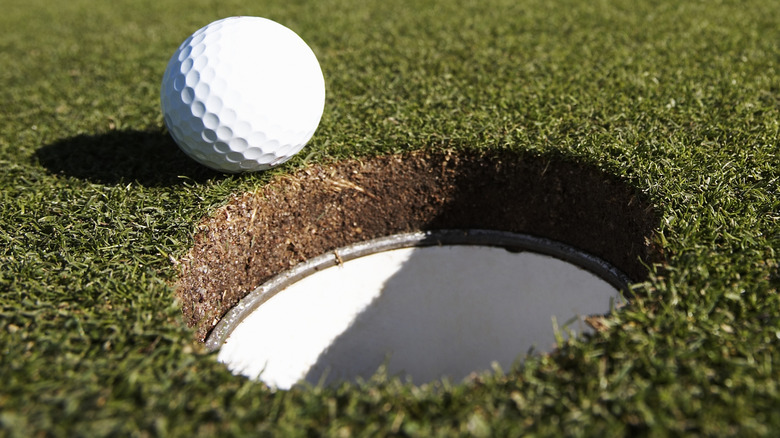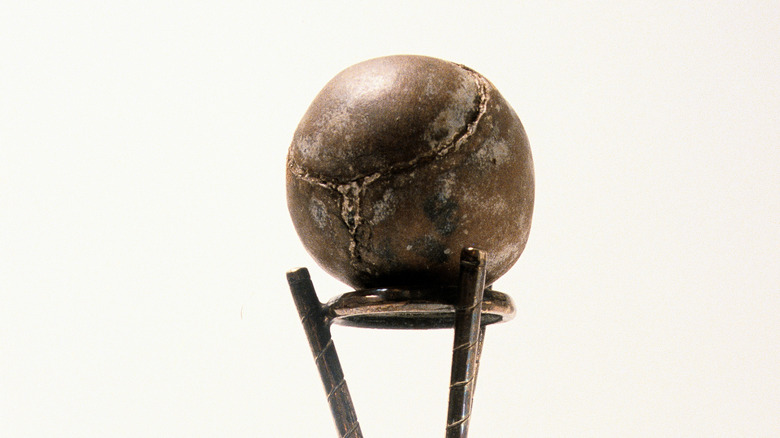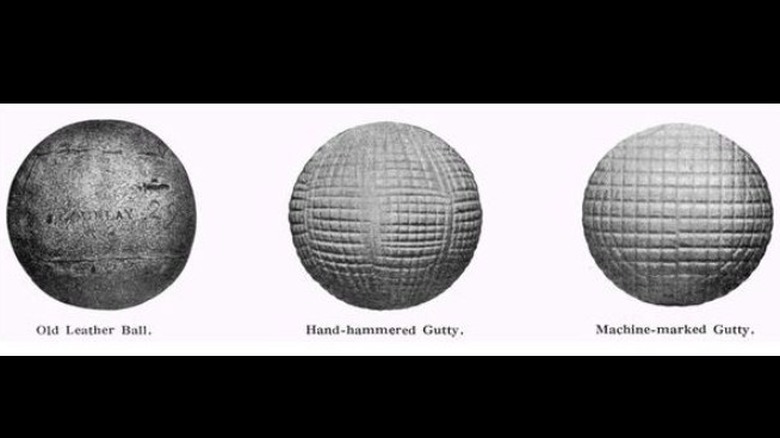Why Golf Balls Were Filled With Feathers Up Until The Mid-19th Century
At first glance, a feather and a golf ball seem like opposites. One is soft, light, and floaty. The other is hard, remarkably heavy for its size, and barely even bounceable. That's why it's surprising that golf balls were once stuffed with feathers. A type of golf ball called a "feathery" or "featherie" was the sport's ball of choice for around two centuries, according to Scottish Golf History.
The feathery was made by stuffing cow leather with goose feathers, according to St. Andrews Golf Co. Three pieces of wet leather would be stitched together and turned inside out and then wet feathers would be stuffed into a slit, according to Scottish Golf History. As both materials dried, the leathery casing would shrink while the feathery interior would balloon. The pressure would then harden the ball, according to Professional Golfers Career College. A hard ball is able to fly farther when whacked with a club, so something of the spirit of the bird was retained in the feathery golf ball.
From wood to feather
Golf experts are unsure what the first golf balls were made from. Similar sports played in northern Europe like Colf, Crosse, and Mail used wooden balls, according to Scottish Golf History, but there is no definitive proof that wooden balls were ever used in Scotland, which is where the modern game emerged, according to Historic UK. The first documented golf balls were called hairy golf balls. These were made from cow leather stuffed with either cow's hair or straw, according to Professional Golfers Career College, and they were likely first imported from the Netherlands in 1486.
These were the main balls used until 1618, when the feathery was first invented. The first reference to the ball is actually in a Dutch poem from 1657, which refers to the whacking of a "fennebal," or feather ball, with a Scottish cleek, Scottish Golf History noted further. (A cleek was an old name for a golf club with a wooden shaft and iron head, according to Sports N' Hobbies). However, because the cleek in question is Scottish, it's possible the feathery was first invented in Scotland and then made its way to the Netherlands. Featheries were more desirable than hairies because they could be stuffed fuller and were therefore harder, according to Professional Golfers Career College. However, they also took longer to make and were therefore more expensive. Because of this, cost-conscious players continued to use the hairies into the early 1700s.
The rise of the Guttie
The feathery was the reigning ball in golf until the mid-1800s. In 1836, the record was set for how far a feathery could fly, at 361 yards, according to Scottish Golf History. Twelve years later, the feathery's main competitor and ultimate replacement was invented, according to Professional Golfers Career College. This was the Gutta-Percha ball, or Guttie, which was made with sap from the Malaysian Sapodilla tree. At first, the ball was not extremely popular because players were not convinced it flew any farther, according to Scottish Golf History. What it was, however, was cheaper, at around one shilling per ball. This allowed more people to buy golf balls and enhanced the sport's popularity.
The Guttie is also responsible for the pockmarked look of the modern golf ball, when it was discovered that marks accidentally left on the balls actually made them travel farther, according to Professional Golfers Career College. Soon, the marks were made on purpose by manufacturers.
Today, most golf balls are made from rubber. While featheries are no longer the go-to golf ball, you can still find them. Featheries from the 19th century sell for thousands of British pounds at auctions, according to Scottish Golf History.


